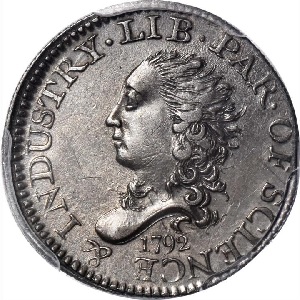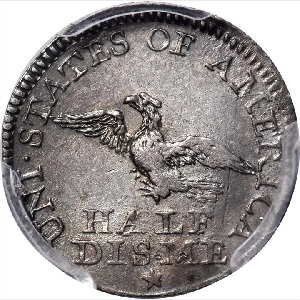1792 Half Disme
Upon ratification of the United States Constitution in 1788, one objective of the framers was to help forge a national identity through the issuance of its coinage.(1)
The 1792 half disme was the first coin to be officially sanctioned by the U.S. government after the Constitution went into effect. A total of 1,500 of these smallish five cent coins was struck sometime between July 11 and July 13, 1792, in the cellar of Philadelphian John Harper. The foundation stone of the new Mint building, just two blocks from Harper’s property, wasn't laid until July 31.
There is some confusion over the proper pronunciation of “disme.” It is from the French language, evolved from the Latin word “decimus,”(2) meaning one-tenth, and is pronounced as “deem.”(3)
“Disme” appeared only on the 1792 half dime and the ultra-rare 1792 disme patterns. The spelling was never used again on a U.S. coin. The word we use today, “dime,” wasn’t stamped on U.S. coinage until 1837, on the half dime and dime.(4)
Popular folklore says the silver for the batch of half dismes was donated by George Washington, but historical documents prove it was Thomas Jefferson, not Washington, who was more closely involved in the production of the 1792 half dismes.(5)
Jefferson wrote in his private account book of a $75 in-person delivery to the Mint on July 11. On July 13, he recorded: “Rec’d from the Mint 1500 half dismes of the new coinage.”
With a bounty of freshly minted silver coins in his possession, Jefferson left Philadelphia the same day for summer vacation in Virginia, where his notes indicate he apparently spent most of the half dismes.
Experts have debated if the 1792 half disme should be classified as a pattern piece or a circulation strike, but the predominance of evidence suggests the latter. President Washington himself declared in his fourth annual address to Congress on November 6, 1792 that the half dismes were indeed intended for regular circulation.
As the premier coin issued by the United States, the 1792 half disme occupies a position of high honor in the pantheon of numismatics. Because some of the most influential Founding Fathers had a direct hand in its making certainly enhances its prestige.
In 1914, renowned artist John Ward Dunsmore was commissioned to paint a scene depicting the presentation of a newly struck 1792 half disme example to President and Mrs. Washington. Entitled “Washington Inspecting the First Money Coined by the United States,” the work also features Treasury Secretary Alexander and Mrs. Hamilton, Washington’s secretary Tobias Lear, Secretary of State Thomas Jefferson, Mint Director David Rittenhouse, and Mint workmen Henry Voigt and Adam Eckfeldt.(6)
Although there is no evidence of this gathering of dignitaries, Dunsmore’s masterpiece has touched the hearts of collectors for generations, for it nostalgically and accurately connects the birth of the nation to America’s coinage. Perhaps this partially explains the rocket ship ride the 1792 half disme has enjoyed in price performance for many decades.
| Estimated survivors in all grades: 275 ?
The survivor estimate from PCGS represents an average of one or more experts' opinions as to how many examples survive of a particular coin in all grades. Survival estimates include coins that are raw, certified by PCGS, and certified by other grading services. Learn more at PCGS. |
| PCGS Rarity Scale: 6.5 ?
The 'PCGS CoinFacts Rarity Scale' assesses the relative rarity of all U.S. coins, based on estimated surviving examples. The scale runs from 1.0 to 10.0. The higher the number, the rarer the coin.
Learn more at PCGS. |
| Click HERE to check for availability on eBay** |
Preview of eBay selection (you can usually find a couple of 1792 half dismes for sale using the HERE link above):
 |
 |
| Trendline Avg = 35.52 | BEST |
Historic Value Trend Charts:
| Last updated 2-5-25 | Return to Key Date Coin List | |
| There are no Common Date comparisons for this coin. | ||
|
|
||
| Download Charts to Your Computer | ||
Sources
1. Taxay, Don. The U.S. Mint and Coinage. New York, NY: Sanford J. Durst Numismatic Publications, 1966.
2. PCGS. Bust Half Dime.
3. Garrett, Jeff and Guth, Ron. 100 Greatest U.S. Coins, 5th ed. Pelham, AL: Whitman Publishing, 2019.
4. PCGS. Bust Half Dime.
5. Garrett, Jeff and Guth, Ron. 100 Greatest U.S. Coins, 5th ed.
6. Orosz, Joel J. and Augsburger, Leonard D. The Secret History of the First U.S. Mint. Atlanta, GA: Whitman Publishing, 2011.
**Many very fine coin dealers sell on eBay. At any point in time, there may be over one million search results for United States coins. This includes quite a few of the recommendations on our Key Date Coin List.
If you’re thinking about purchasing a rare coin, eBay is certainly worth a look. For your convenience, the links from this site to eBay are coded to bring up only coins certified by PCGS and NGC.
As is always, always the case, never buy a valuable coin from a seller whose trustworthiness cannot be verified. Learn more about this at our chapter Best Places to Buy Coins, which also has a section on doing business on eBay.
In the interest of full disclosure, Rare Coins 101 receives a small commission anytime someone connects to eBay from this site and purchases something.
Coin Images by Stack's Bowers Galleries.


